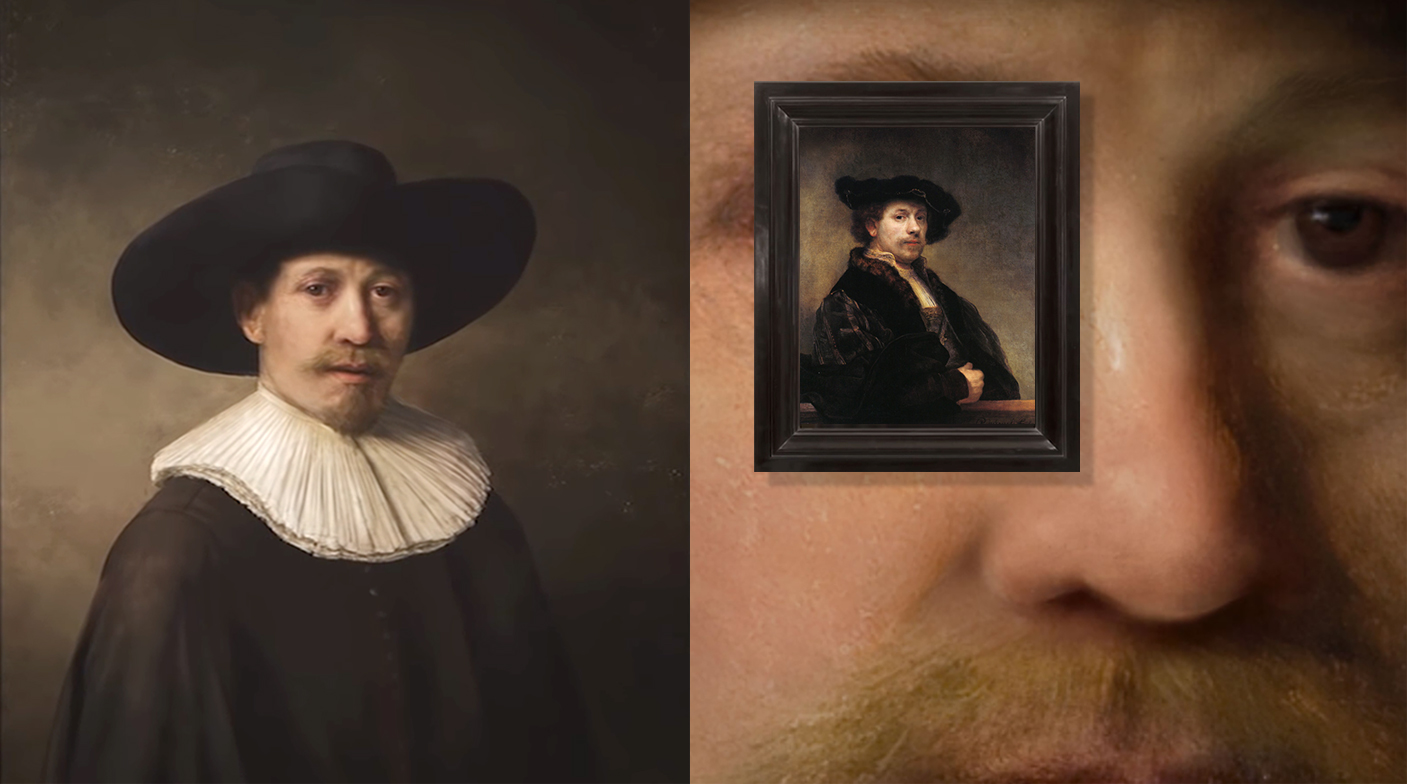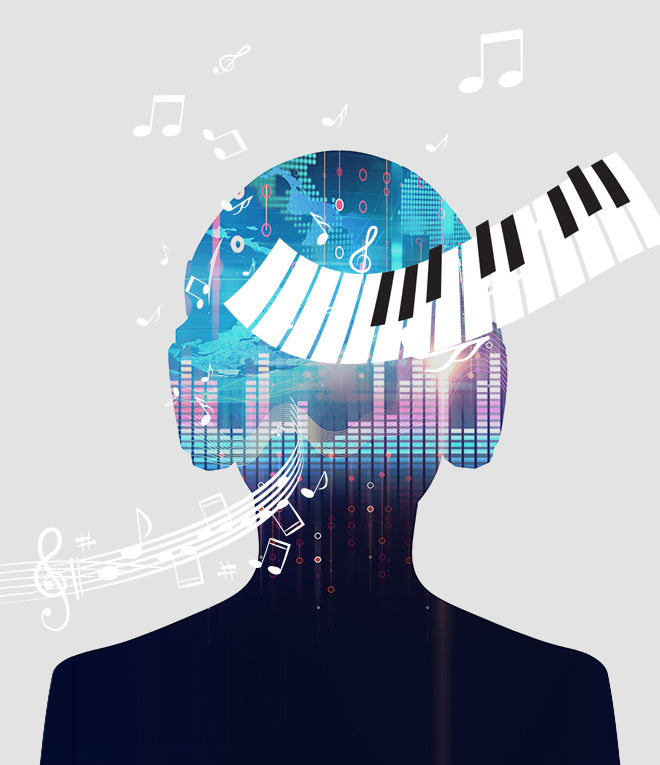ENG VOL.49
February 2019


Special ____ New Chapter of Creation Begins
Where Art Meets
ICT, New Chapter of
Creation Begins
The ability to create art has so far been recognized as unique to humans. With the rapid advancement of science and technology, and especially ICT, however, the scope of art is evolving accordingly. ICT solutions are now being applied to performing art while AI is increasingly permeating every aspect of culture and art, e.g., composition and painting. This Issue guides you through the marvelous advancement of ICT toward culture and art.


Image of the Olympic flag created with 1,218 drones at the opening ceremony of the PyeongChang 2018 Winter Olympics © intel
ICT, Painting the Future of Performing Art
The advancement of ICT has not been limited to a specific field but to various areas, all the while expanding the scope of art. For example, various fields, including AR, VR, drones, holograms, and media are proactively seeking to converge with art.
The drone show, presented at the opening ceremony of the PyeongChang 2018 Winter Olympics, filled the sky with images of the Olympic flag and Soohorang, its official mascot, using as many as 1,218 drones. The show was tangible proof of the successful implementation of programming, the essence of SW, as well as drone stability, and communications and control technology. This is how ICT entertains and touches people’s hearts all over the world.
Another example is holograms. How would it feel if your favorite singers who had died a dozen years ago appeared on stage as they were in their prime? This became a reality at the 2014 Billboard Music Awards, where Michael Jackson, dubbed the "King of Pop," gave a live performance. At the K-Live Performance held at the Nuri Dream Square in August 2018, Jae-ha Yoo, a Korean singer who died 30 years ago, appeared on stage, singing his hit song, “Days Gone by,” jointly with Sweet Sorrow, a contemporary band, and striking the emotional chords of the audience. In recent years, hologram technology has advanced to the point where users can feel as if subjects were right in front of their faces, i.e., realistic content technology, and expectations are still high for the technology to further advance and make tangible achievements. However, there is a long way to go. The hologram technology showcased during those performances was a pseudo-hologram technique, which combines 2D imaging technology with special effects. The development of the holographic display technology that can allow multiple viewers to enjoy 3D images from any direction in 360 degrees is still at an early stage.

Image of a hologram live-performance of late Jae-ha Yoo © 3DFACTORY
Researchers from global universities and institutions, such as the Massachusetts Institute of Technology (MIT) and the National Institute of Information and Communications Technology (NICT), have been studying to implement the technology above, but the implementation has been limited to a specific range of angles due to technical limitations.
Then, how far has hologram technology advanced today? As for now, the one closest to perfection is Tabletop Holographic Display, which is under development by ETRI. It is now capable of building 3D color videos with a size of four inches, viewable from any direction. Further research on the improvement of this technology’s performance, function, and structure is essential to overcoming the limitations of existing 3D display technology and thus expanding the scope of its application to various fields, including education, training, construction, national defense, and art.

Image of a bird drawn by Deep Dream, AI painting software, using fractals
© deepdreamgenerator.com
Story of Painting by AI
Recently, the use of AI has been dramatically emphasized in the art field. Deep Dream, one of the leading AI-based painting programs developed by Google, is a visualization code using an artificial neural network distributed by the Google Research Blog. Deep Dream draws images by using fractals that are infinitely repeated in a similar structural pattern. If you enter an image of a bird, as shown on the left, into the program, its algorithm will process the image into the one shown on the right. This algorithm divides a given image into a series of elements and identifies specific patterns in them to recognize what the image contains. Simply put, this AI algorithm transforms an image so that it can be recognized as having a specific pattern, which might match one of the patterns that the algorithm has obtained through machine learning. By doing so, a simple image of a bird can be reinterpreted as an image comprising various patterns of circles and lines.
This type of AI is based on deep learning technology. Deep learning simply refers to a technology that enables machines to think and judge as humans do. The technique allows AI to spot patterns among given data sets and find matches on its own. In this way, any object, commonly seen in our daily lives, can be transformed into abstract and artistic images.
There is an advanced form of Deep Dream that can learn to recognize the texture of an image. This program is based on an algorithm that creates and adds a new texture to a given image while keeping the other contents of the image the same, thereby generating a new version of the image. Meanwhile, the Rembrandt House Museum and Microsoft have jointly developed AI painting software named Next Rembrandt. It is the actualization of an AI painter that has a painting style similar to that of Rembrandt van Rijn, one of the greatest painters in Dutch history. Next Rembrandt has demonstrated the implementation of typical textures and coloring techniques that are prominently found in oil paintings by analyzing Rembrandt’s 346 portrait paintings through facial recognition technology and subsequently applying a 3D printing technique
The Next Rembrandt
Analyzes Rembrandt’s portrait paintings through facial recognition technology and implements oil painting coloring techniques using 3D printing

Portrait painted by the Next Rembrandt, AI software, which has a painting style similar to that of Rembrandt (left) © The Next Rembrandt / Self-portrait at the Age of 34(right) © The National Gallery

Magenta Project, which aims to design Google’s AI algorithm for art creation and learning
Music Converged with AI Technology
There have been numerous attempts to apply AI solutions not only to the art field but also to the music industry. A case in point is the Magenta Project. The project is aimed at creating new music by building a database that contains a thousand musical instruments and 300,000 notes. Subsequently, researchers train AI with those data sets, in cooperation with the UK's DeepMind. The ultimate purpose of this project is to create rich tones that people can enjoy and to invent new musical instruments by using a machine learning algorithm that can teach itself. This project is now viewed as having brought ICT solutions into the realm of creation.
In June 2016, the Magenta Project released a piece of piano music with a running time of 90 seconds. It was composed using Google's machine learning software named Tensor Flow. This piano piece, originally written by AI, was set to an orchestral and drum accompaniment performed by human musicians.
In Korea as well, an attempt to apply AI technology to music composition was made by Arts in Mankind (A.I.M), a music label established by Jukedeck, a UK music startup, jointly with EnterArts, a Korean record producing company. In February, EnterArts held a showcase to celebrate the launch of A.I.M, the world’s first music label that combines AI solutions and human emotions. Once the AI composer writes a piece of music, human musicians write lyrics for it and arrange and sing the song. This is the beginning of a new chapter, where anyone can make music.
The convergence between art and ICT is still underway. Drones are flying over our heads providing a view completely different from that which would be visible from the ground, while transforming the view into an artistic painting. Pseudo holograms bring back dead musicians and invite them to sing for us. However, this is not the end. Soon, art combined with ICT solutions will become part of our daily lives. Our hopes and expectations are high as we are moving into completely new chapters of our lives that we haven’t even been able to imagine.
Jukedeck
Has established Arts in Mankind (A.I.M), the world’s first music label that combines AI solutions and human emotions, in cooperation with EnterArts, a Korean record producing company



